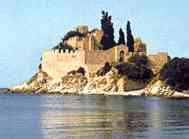










Monastery Chilandar
on Holy Mountain of Athos
in this, 1998 year the Chilandar Monastery celebrates its 800th Anniversary as
the Serbian Orthodox Monastery
| |

The most important benefactor of Chilandar monastery was Serbian
King Milutin (1282-1321), exposing Serbia to stronger Byzantine social and cultural
influence by incursions into Byzantine territory in Macedonia. He in 1293, built a new
main church on the foundations of the old one, extending existing fortifications; in 1302
he built Hrusija by the harbour and so-called Milutin's
Tower.

At the end of the 14th century and in early 15th century, during
Serbian princes and despots, the Chilandar's property continued to expand. Prince Lazar
(1371-1389) added to the main Chilandar church so-called Lazar's narthex. It was before
the Battle of Kosovo.

TZAR DUSHAN’S CROSS Halfway
between the sea and Chilandar stands a cross-like sign. It was erected by Tzar Dushan the
Mighty on the very place where he was met by the Chilandar community. Carrying icons and
relics, the Chilandar monks greeted him with bread and salt. It happened in 1347 when the
Tzar took refuge with his family and train on Mount Athos, fleeing from the epidemic of
plague in Serbia.

Karyes, the building of the Holy Community
and bell-tower of the Protaton.

Chilandar, the main church, a baroque pyrgos (18th century), and
the pyrgos of St. George, view of the southern side of the Monastery courtyard.

KONAK - MONASTIC QUARTERS According to the Athonite and
Byzantine
rules, all monastic quarters were built within the enclosure walls. Old Chilandar
monastic quarters have not been preserved. The present-day quarters date from the period
between the late 16th and the late 17th centuries. The legend has it
that some of the distinguished Chilandar people lived in those cells. The cells of the Old
Symeon and Monk Sava are in the small residence building near the well. On the first floor
of the residence building near the Church of the Virgin’s Shroud is the cell of
Paisios of Chilandar, "the father of the Bulgarian
history".

The western part of the residential building added in the 19th
century. This period saw the last major architectural undertakings, all springing from the
medieval nucleus, so that there are no marked transitions between the various
architectural strata.

The eastern part of the Monastery with pyrgos of St. Sava,
parekklesion of St. Archangel and the new library.

KING MILUTIN’S TOWER On the road leading to the
Chilandar monastery, in a place close to the sea called Sava’s field, King Milutin
erected a defense tower at the beginning of the 14th century. It was called
after him "King Milutin’s Tower" and is still well preserved. Being over
forty meters tall, it is the highest building on Mount Athos. It has a rectangular ground
plan and consists of ground floor and five stories connected by a spiral masonry
staircase.
According to the Holy Mountain tradition, there was a paraccleseion, a small chapel, at
the top. The view from the top, both of the sea and land, was excellent, so the monastery
could be advised of danger in good time. It was in this tower that Empress Helen, consort
of Dushan the Mighty, stayed at the time of plague epidemic in Serbia, in 1347. In order
to prevent a woman’s foot to touch the sacred ground, the Empress was carried in a
sedan chair from the port to the tower.
|
|
Chilandar under Turkish occupation
The first Turkish occupation of the Holy Athos occurred in 1387, and 1393-1403, and
finally in 1430. The Ottoman Empire sanctioned the autonomous organization of the Holy
Athos, but it lost many of its estates and revenues outside peninsula, and was burdened by
taxes. So it happened to Chilandar monastery, too.
In 16th century the czars helped Chilandar allowing its monks to collect
contributions in Russia. During the 16th and 17th century and later
an important source of income for Chilandar monastery was contributions from devoted
Christians throughout the Balkans. On the other hand, Serbian patriarchs, bishops and
clergy continued to assist Chilandar.
During the Greek uprising 1821, the Turks introduced severe reprisals and imposition
of 10 year occupation, when a large number of monks had fled from the Holy Athos. Many
antiquities and art treasures were destroyed.
But, beside of many tragic events throughout its history after the Nemanjic's period,
the Chilandar library today contains about 1000 Slavonic manuscripts and nearly 180 Greek
codex and booklets from 12th to 19th century; a collection of 80
copies of old Serbian and Wallachian printed books, and excellent specimens of Cetinje
icanubula. There are also copies of almost all works of monastery's manuscripts and
medieval Serbian literature (12th to 17th centuries) both originals
and translated from Greek. This makes the richest treasury of old Serbian literature and
manuscripts. There are also Bulgarian, Macedonian, Russian, and Slavonic works from
Romania. Today's Chilandar library reflects and confines the international ecumenical
character of the Holy Athos monastic community "which has unified the culture of all
the Orthodox nations from the Middle Ages through the Turkish period down to the present
day."
|
|
|
|
|
|
|
|
|
|
|
|

|
|
 
|
